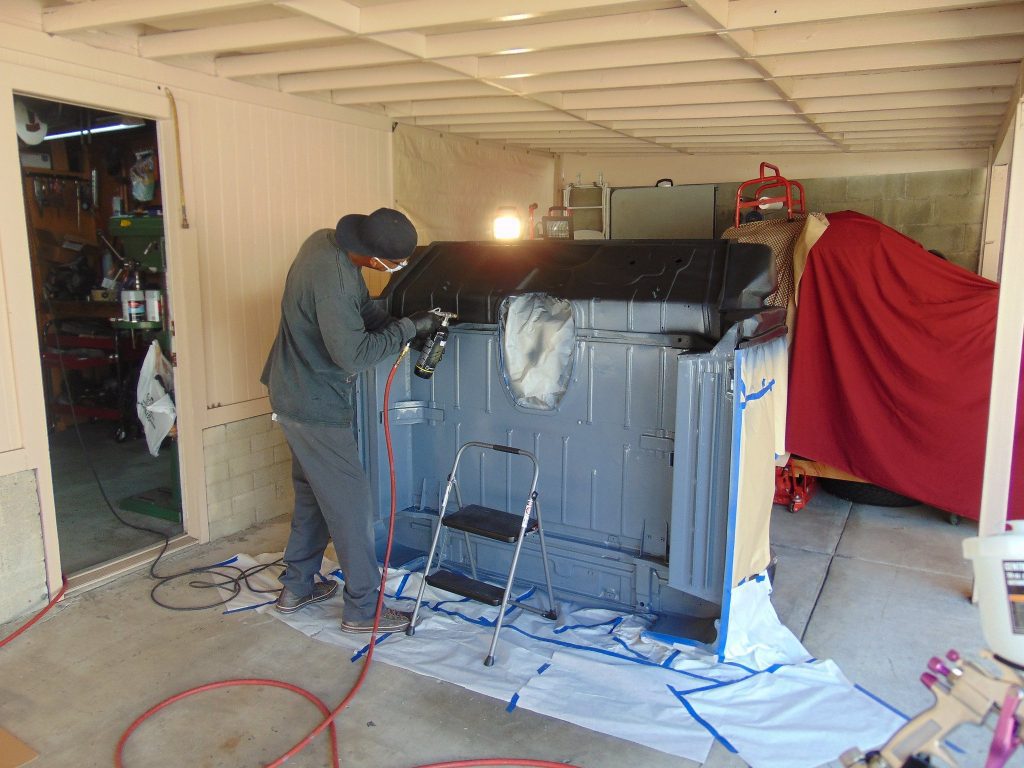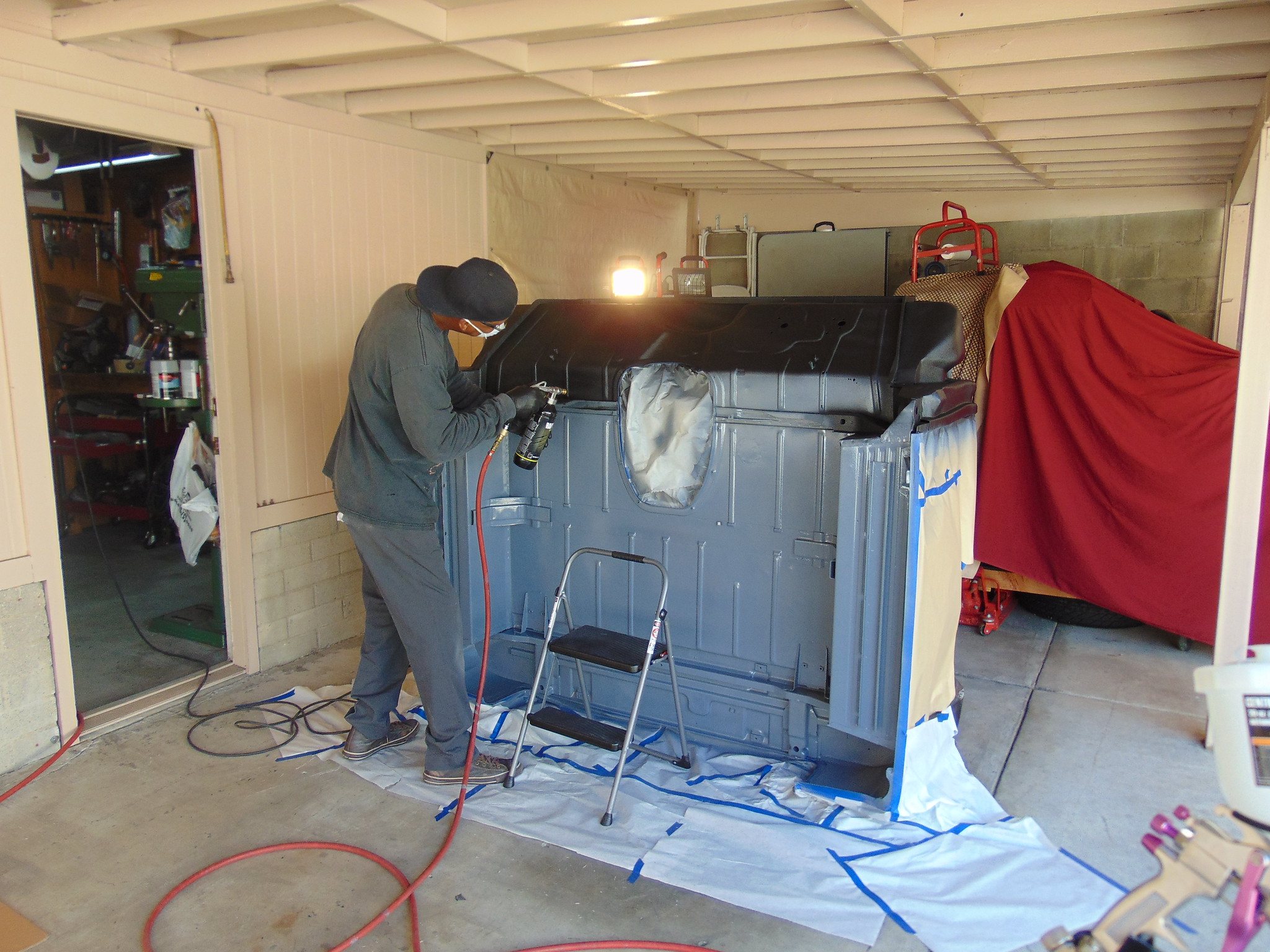Truck bed liner, aka “Rhino Liner” was a great invention of 1988. A solid elastoplast polyurethane material,has protected the rear and beds of thousands of trucks since it hit the market. Today, we have many imitations on the market, some with a similar chemical makeup and others which are quite different, including at least one that includes epoxy.
Part of what makes these bed liner made products so durable is that they are designed for a thick even coat-heavy application. Logically speaking, a thick application of any paint product will be a bit more durable than a thin one. But that’s not all that bed liners have going for them.
The materials used remain somewhat flexible, while not being easily torn. That allows them to absorb and survive a bit of abrasion and impact from sharp corner and edges, the bane of any painted furniture or similar product or surface.
The durability of these products has led to them being used in a large variety of other ways. Some people are painting truck bodies with them, rather than just the bed. The high durability of these products is great for off-road driving, protecting the truck from scratches caused by the weather and pushing through sand and underbrush.
As people experimented more and more with these durable products, they found that Rhino Lining provides an attractive finish for decks, patio furniture, boats, outside stairs and many other surfaces where durability is key. Unlike most paint products, the thick coating of elastomeric resin and polyurethane doesn’t rub or peel off easily, providing a beautiful finish for years, where normal paint would rub off.
Unlike most bedliner products which have been created for application on metal, Rhino Liner and other bed liners work just about as well on wood, marine plywood, and other substrates, as they do on metal. However, it’s a good idea to check the specific product before buying a bedliner though plywood though, as not all of them bond to wood and marine plywood just as well as they do to other materials.
Surface Prep is King
No spray painted product is going to stick well to an improperly prepared surface; and marine plywood, and truck bed liner is no different. Proper surface prep of marine plywood, or decking is essential, especially if it is old wood that the weather has weathered.
Start by cleaning the plywood surface thoroughly to remove dirt and debris. A non-chlorinated, abrasive household detergent, like Spic ‘n Span is ideal for cleaning off any dirt buildup on or underneath the surface of plywood. Being a soap product, it will remove oils that may be sitting there as well, leaving plywood with a clean, smooth surface. Allow the ply of wood to dry after cleaning it, then sweep or vacuum it again to remove any loose dirt.
Like many coatings, truck bed liner adheres best to a rough surface, rather than a smooth one. Roughing the surface up with 60 grit sandpaper and a random orbital sander will help promote adhesion, giving the material of the bed liner something to stick or “bite.”
Once sanded, wipe the surface down with xylene to remove any oil, varnish or paint. Xylene is a common solvent, used for the removal of a wide variety of paint products, as well as being used as a fine general-purpose cleaner.
Applying the Bed Liner
Although truck bed liner stuff is often sprayed, when it is professionally applied to a truck bed, it is best to use a roller or similar product used for applying it to wood or plywood. The spray nozzle that comes with some truck bed liner stuff or kits for spray deposits a very small amount of the product at a time. It spray stuff is also a thinner product, like spray paint is thinner than brushing enamel from a can. Spraying stuff won’t provide as heavy or durable a finish as applying with a roller.
Roller nap length is usually determined by the heaviness of the coating the material and texture of the material on the plywood substrate. For smooth, sanded plywood, a 3/8” to 1/2” roll nap is ideal. A thinner nap will not hold as much coating, or moisture, while a thicker one will tend to leave runs and puddles.
Open the can of product and mix thoroughly, being sure to scrape the edges and bottom and seal the sides of the seal the can. Then pour a small amount into a paint roller tray, only covering the edges and bottom. It’s best to avoid getting a lot on the roller at one time, as too much product will just puddle, causing runs in the finish.
An ideal application will cover the surface in one stroke, without having to go back and forth over the same spot a second coat. At the same time, there should not be any puddle of paint deposited by the edge of the roller.
Work from the bottom line x the farthest corner line to the top line x the nearest bottom line x back, applying an even coat throughout. There may be some spots where the roller can’t reach. In those cases, a foam brush can be used.
A stabbing motion with the foam brush will provide for a fine finish texture which is much like what the roller provides. Be sure to have spare foam brushes, as they don’t last all that long.
A second coat of the product should be applied, before the first coat is fully dry. The project might even require two coats or a third coat, at least two coats in places (especially end grain), as the dry wood will soak up a lot of moisture of the moisture from the finish. Once the entire surface is coated, allow the first coat of product 24 hours to dry before doing anything further.

Spraying bed liner, ATOMIC Hot Links
Using Rhino Liner on a Truck Bed
Applying Rhino Liner or another truck bed coating to seal a truck bed is similar to applying it to seal it on plywood. However, if the vehicle is old, rust is a big concern. While it is not necessary to remove all rust, it is a good idea to remove surface rust, especially loose painted surface with rust. Once the rust is removed and painted surface, automotive primer should be applied, covering all the places where bare metal is showing.
It is cheaper and usually better to spray mausoleum bed liner onto a truck, first coat although it can be rolled and brushed. However, there are places on a truck bed which are very hard to reach with a paint roller and may even be hard to reach with a brush. So it’s better to use a sprayer, ensuring that no parts of vehicle with the sprayed mausoleum bed liner are missed, especially up under the rear lip (the easiest place to miss).




